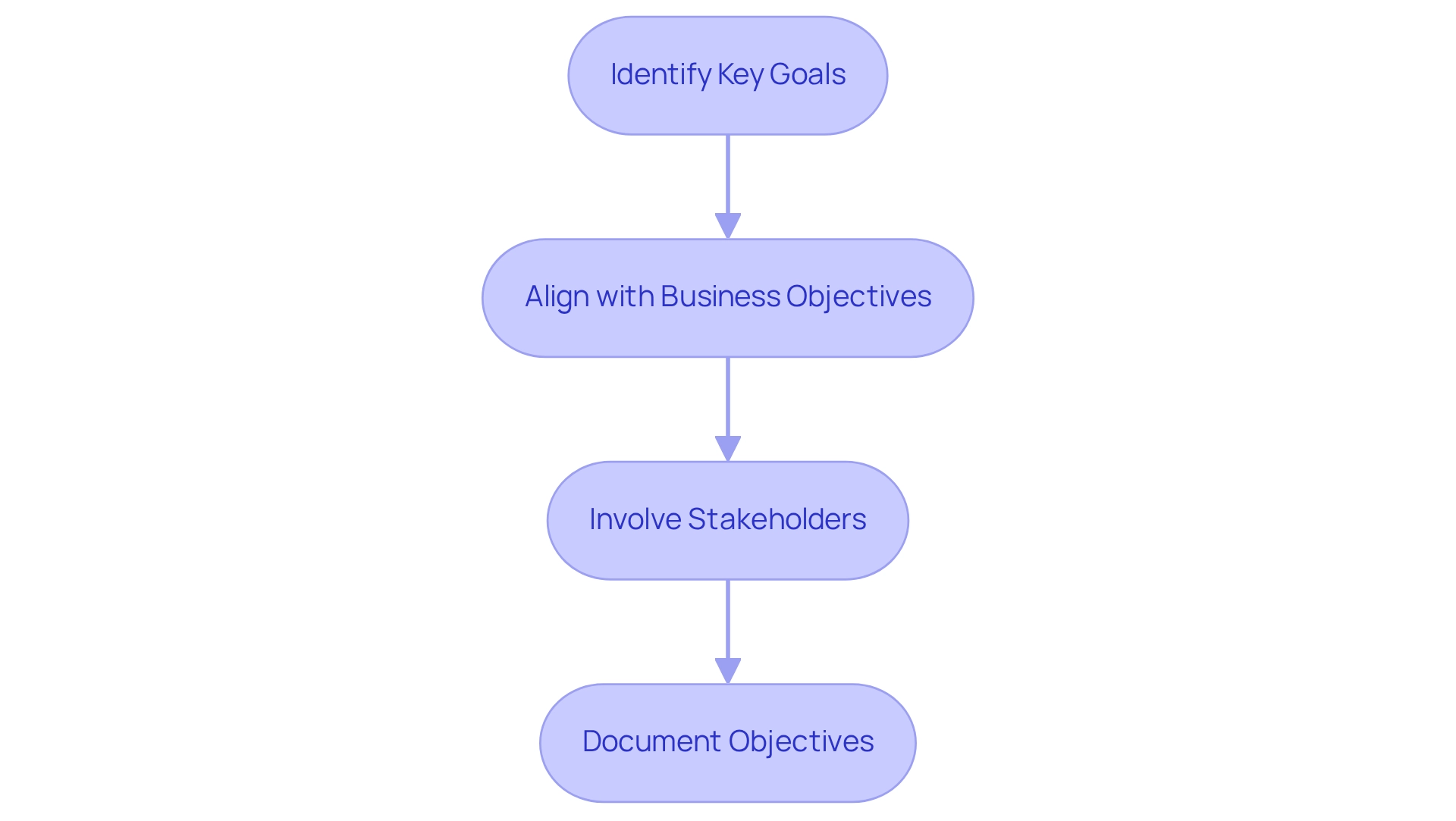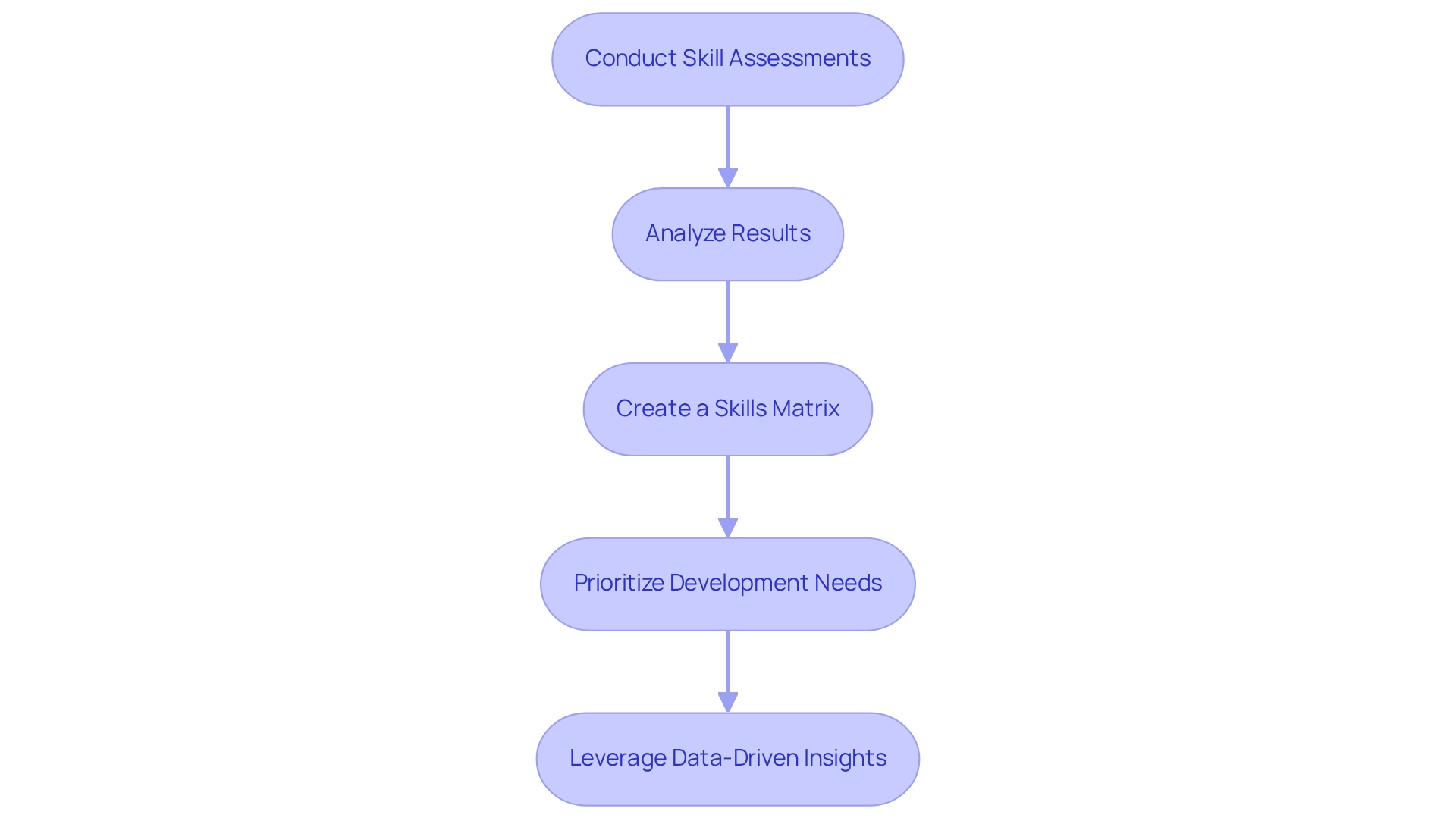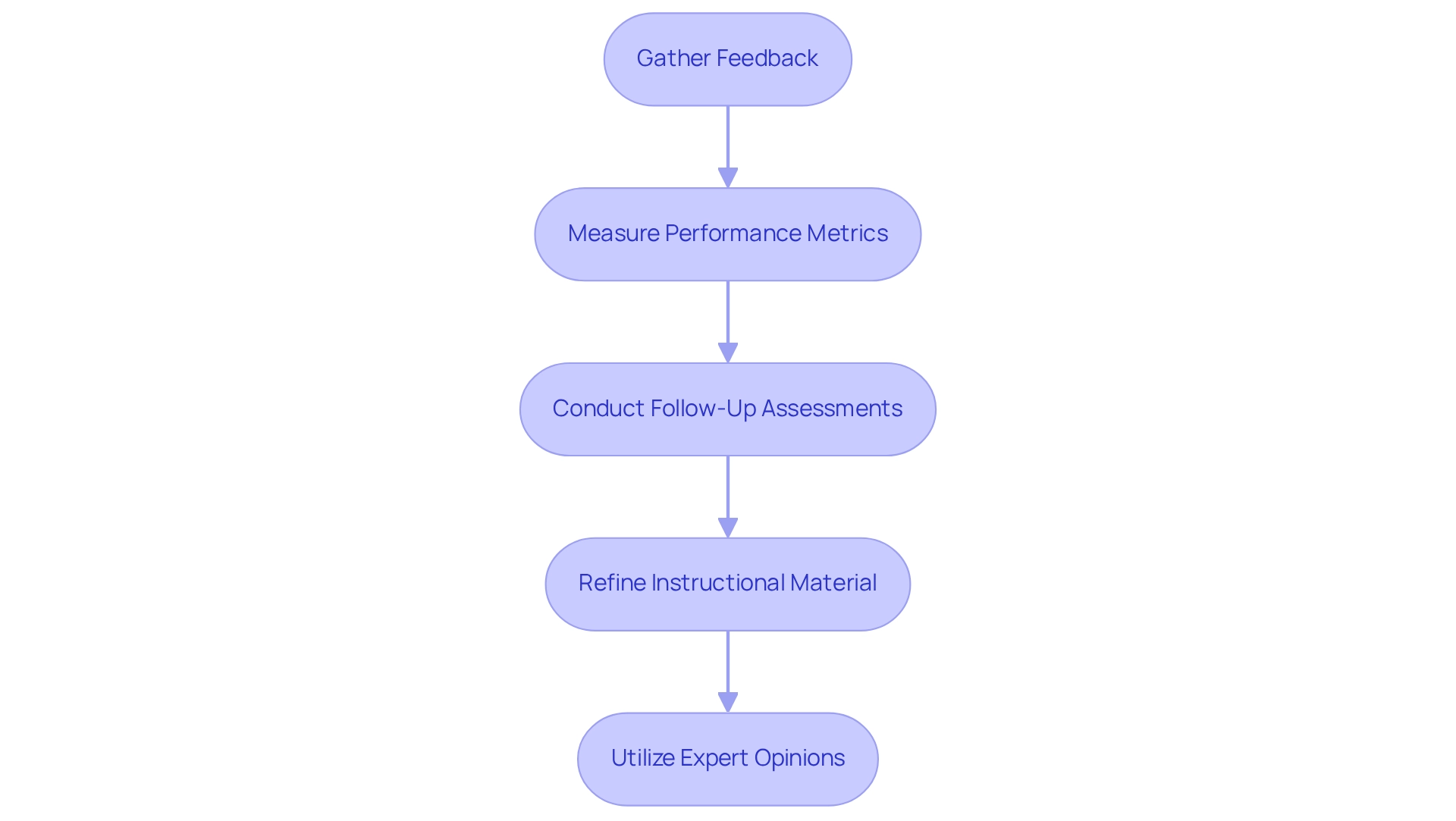
Remote Team Documentation Strategies
|
October 17, 2025
|
5 Steps for Effective Employee Software Training Implementation
Overview
You might be wondering how to effectively implement employee software training, right? Well, the article outlines five essential steps to get you started:
- Defining clear training objectives
- Assessing employee skill levels
- Designing engaging content
- Providing ongoing support
- Evaluating training effectiveness
These steps come with practical strategies that really make a difference. For instance, involving stakeholders in setting objectives can lead to better alignment, and using diverse evaluation methods for skill assessments keeps things interesting.
Now, let’s dive into how you can enhance engagement. Think about leveraging multimedia elements—like videos or interactive content—to make learning more fun and effective. All of this is aimed at maximizing the training impact while aligning with your business goals. So, why not explore these strategies and see how they can transform your training approach?
Key Highlights:
- Identify clear goals for employee software training to measure success, such as boosting productivity or reducing errors.
- Align training objectives with broader business goals to enhance relevance and effectiveness.
- Involve stakeholders like team leaders and employees in the development of training objectives for greater relevance.
- Document objectives to maintain alignment and improve workforce engagement during training initiatives.
- Conduct skill assessments using diverse evaluation methods to identify gaps in employee software skills.
- Analyze assessment results to pinpoint common weaknesses and plan targeted development initiatives.
- Create a skills matrix to visualize competencies and identify specific skill gaps in the workforce.
- Prioritize development needs by focusing on essential skills to maximize training efficiency.
- Leverage data-driven insights and tools to analyze training requirements and enhance employee software training solutions.
- Choose engaging formats for training content, such as videos and interactive modules, to meet learner expectations.
- Incorporate real-world scenarios and multimedia elements to enhance training relevance and retention.
- Include assessments in training to provide feedback and reinforce knowledge retention.
- Schedule instructional sessions effectively to boost learning outcomes and knowledge retention.
- Ensure easy access to training resources, allowing employees to take charge of their learning.
- Establish a support system for ongoing assistance post-training, promoting employee retention and satisfaction.
- Encourage peer learning to foster a collaborative environment and enhance knowledge sharing among employees.
- Gather feedback after training sessions to evaluate content effectiveness and participant experience.
- Measure performance metrics to assess the impact of training on productivity and error rates.
- Conduct follow-up assessments to track knowledge retention over time and identify further training needs.
- Refine instructional material based on feedback and performance metrics to improve future training sessions.
- Utilize expert opinions to adopt best practices in training assessment and ensure alignment with business needs.
Introduction
In today’s competitive world, you might be wondering how effective software training can really make a difference for your organization. As companies work hard to boost productivity and streamline their operations, the real challenge is creating training programs that not only fill those pesky skill gaps but also engage employees in a meaningful way.
By following these essential steps, organizations can build a solid training framework that meets both employee needs and business goals:
- Set clear objectives
- Assess what skills are already in place
- Design content that’s anything but boring
So, let’s dive into the essential steps for crafting a successful software training initiative, ensuring your teams are ready to harness technology effectively and drive your organization’s growth.
Define Objectives for Software Training
- Identify Key Goals: You might be wondering how to kick things off with . Start by figuring out what you really want to achieve through employee software training. Are you looking to boost productivity, improve software skills through employee software training, or cut down on errors? Setting clear goals is super important for measuring your success.
- Align with Business Objectives: Now, let’s think about how your learning objectives can sync up with your company’s bigger picture. For instance, if your organization is focused on enhancing customer service, your training should zoom in on software features that help with customer interactions. This connection is crucial—did you know that 83% of organizations see the value in developing leaders at all levels through employee software training? It’s all tied to effective training!
- Involve Stakeholders: Don’t forget to bring in team leaders and employees for their input on what should be included in the development objectives. This collaborative approach not only makes the employee software training program more relevant but also ensures that it meets the needs of those who will actually be using the software.
Document Objectives: Once you’ve got your objectives down, write them out clearly and share them with everyone involved. This documentation serves as a handy reference during the development process, keeping everyone aligned with the goals. A well-documented objective framework can really amp up workforce engagement. Just look at Zillow—they aligned their career development strategies with remote operations, which boosted staff performance and adaptability. Plus, with 49% of respondents not fully participating in required employee software training sessions, it’s essential to create engaging programs that align with business goals to enhance involvement and efficiency. By following these steps, you can lay a solid foundation for your employee software training initiatives, leading to better staff performance and productivity. Curious about how SowFlow can help you hit your training objectives? Feel free to reach out!

Assess Employee Skill Levels and Identify Gaps
- Conduct Skill Assessments: You might be wondering how to get a real grip on your team's software skills. Well, implementing a mix of evaluation methods like surveys, quizzes, and practical tests can do just that! Think about including both self-assessments and evaluations from managers to get a well-rounded view of everyone's skills.
- Analyze Results: Once you've got those assessments in, it’s time to dive into the results. Take a good look at the outcomes to spot any common weaknesses among your staff. Finding patterns can reveal shared challenges, which is super helpful for planning .
- Create a Skills Matrix: Have you ever thought about visualizing your team's skills? Developing a skills matrix can really help! This tool maps out the required competencies against what your employees already know, making it easier to pinpoint specific gaps that need attention.
- Prioritize Development Needs: Now that you've identified those skill gaps, it’s time to prioritize! Focus on the most essential skills first to ensure your team gets the support they need to boost their performance efficiently.
- Leverage Data-Driven Insights: Speaking of support, why not utilize tools like Yaksha for training requirements analyses? These platforms offer data-driven feedback that helps trainers focus on areas where employees need the most help. Plus, integrating SowFlow's user guide creation capabilities means instant access to updated documentation, giving your teams the resources they need to thrive. This approach aligns perfectly with current trends, as more organizations recognize the importance of tailored employee software training solutions to bridge skill gaps in software usage. And remember what Maya Angelou said, "When you learn, teach. When you receive, share." This quote beautifully captures the essence of education and the importance of preparing an informed workforce.

Design and Develop Engaging Training Content
- Choose the Right Format: You might be wondering how to select the best format for your educational content. It’s crucial to pick options that resonate with your audience, whether it’s videos, interactive modules, or hands-on workshops. In 2025, self-directed education and video-based resources are leading the pack, aligning perfectly with what learners expect today. Plus, did you know that eLearning can cut training time by 40-60%? That makes these formats not just engaging but super efficient too.
- Incorporate Real-World Scenarios: Have you thought about how case studies and real-world examples can enhance your training? They’re essential for showing how software fits into everyday tasks. This approach boosts relevance and helps learners retain information better. Organizations that offer personalized educational paths and incorporate into the workday are better equipped to meet the evolving needs of their workforce. Insights from the '2025 Enterprise Learner Preferences Trends' case study really highlight the importance of tailoring educational experiences to individual needs.
- Utilize Multimedia Elements: Engaging educational content should definitely include a mix of multimedia elements—think visuals, infographics, and animations. This variety caters to different learning styles and keeps the employee software training program lively, making it easier for employees to absorb information. By using tools like SowFlow, teams can access user guides that are not only comprehensive but also easily updated, ensuring the documentation stays relevant. Integrating multimedia and accessible documentation through SowFlow can truly enhance the overall educational experience.
- Include Assessments: Now, let’s talk about assessments. Incorporating quizzes or practical exercises during employee software training really helps strengthen knowledge retention and gauge comprehension. This method gives learners instant feedback, which is fantastic for solidifying what they’ve learned. With eLearning, instruction time can be slashed by 40-60%, making assessments a vital part of an effective learning strategy. As the LMS market is projected to hit $28.1 billion by 2025, organizations need to think about the implications of this growth and the necessity for investment in digital educational solutions—especially since some companies are shifting back to face-to-face instruction.
Implement the Training Program and Provide Ongoing Support
- Schedule Instructional Sessions: You might be wondering how to arrange those instructional sessions effectively. It’s all about aligning them with employee availability and the complexity of the content. Spacing out sessions can significantly aid in absorbing information, which is essential for retention. Did you know that research shows well-timed instruction can boost learning outcomes significantly? In fact, optimal scheduling can lead to a whopping 70% increase in knowledge retention! With SowFlow's instant documentation solution, you can simplify this scheduling process, ensuring all educational materials are right there when you need them.
- Provide Access to Resources: Let’s talk about access. It’s super important to make sure educational materials are easily available online. This way, your staff can review them whenever it suits them—think recorded sessions, manuals, and FAQs. When resources are accessible, staff can take charge of their own learning. In fact, findings indicate that 40% of personnel prefer employee software training that is tailored to their individual needs. With SowFlow, you can effortlessly create and update user guides, making sure your team has the most relevant information at their fingertips.
- Establish a Support System: Now, how about creating ? It’s essential to have a place where staff can ask questions or seek help after training. This could be a dedicated chat channel, email support, or even regular check-ins. Continual assistance is crucial; a Harris Poll survey found that 70% of workers would consider leaving their current job for one that focuses on growth and development. That’s a big deal when it comes to employee software training! SowFlow's documentation can serve as a quick reference for your team, minimizing those repetitive inquiries.
- Encourage Peer Learning: Speaking of support, let’s foster an environment that promotes knowledge sharing among colleagues. Encouraging peer learning not only boosts individual understanding but also creates a collaborative atmosphere. This approach can lead to better morale and retention, as staff feel more connected and supported in their roles. With SowFlow's documentation tools, teams can easily share insights and updates, enhancing collaborative learning.
- Implement Best Practices: Finally, let’s dive into implementing best practices for organizing educational sessions to maximize retention. For instance, integrating bite-sized courses that can be completed at any time can really inspire your staff and promote continuous learning. Plus, customizing employee software training programs to meet the specific needs of your workforce can significantly impact employee satisfaction and retention. With SowFlow, you can quickly revise educational materials to reflect the latest best practices, ensuring your team is always equipped with the most pertinent information.
Evaluate Training Effectiveness and Optimize
- Gather Feedback: After your session, it’s a great idea to collect feedback from participants through surveys or interviews. You might want to ask about the content, delivery, and their overall experience. Did you know that 34% of staff admit they skim through compliance details? This really highlights how important it is to effectively involve employees during employee software training.
- Measure Performance Metrics: Let’s talk about performance metrics. Analyzing things like productivity levels, error rates, and software usage stats before and after your instruction can give you some solid insights into the program's impact. Many organizations regularly evaluate after employee software training to figure out its effectiveness, which helps them make informed decisions about future programs.
- Conduct Follow-Up Assessments: You might be wondering how to keep track of knowledge retention. Scheduling follow-up assessments can help you evaluate how well employees are retaining their skills over time. This way, you can determine if additional employee software training is needed, ensuring that everyone continues to effectively enhance their competencies.
- Refine Instructional Material: Based on the feedback and performance metrics you gather, it’s wise to make necessary adjustments to your instructional content and delivery methods for future sessions. Interestingly, around 30% of organizations choose to outsource LMS operations to enhance employee software training by tapping into external expertise, which can be quite beneficial in refining educational content.
- Utilize Expert Opinions: Engaging with industry specialists can really provide valuable insights into the latest methods for assessing program effectiveness. Their perspectives can guide organizations in adopting best practices and innovative assessment techniques for employee software training, ensuring that programs remain aligned with ever-changing business needs. And here’s a thought: as highlighted by PRNewswire, 70% of employees would consider leaving their current job for a company that invests in employee development. This underscores just how crucial effective training is for employee retention!

Conclusion
You might be wondering how to establish an effective software training program. Well, it’s absolutely crucial for boosting productivity and making sure your employees have the skills they need to shine in their roles. By setting clear objectives that align with your business goals, you can create a focused framework that really drives engagement and performance. Plus, when you involve stakeholders in the process, training becomes more relevant and gives employees a sense of ownership.
Now, assessing current skill levels and pinpointing gaps is key to tailoring your training initiatives to meet specific needs. Using data-driven insights helps you prioritize training efforts effectively, ensuring that resources are directed toward the most critical areas. And let’s not forget about designing engaging content! Incorporating real-world scenarios and multimedia can really boost knowledge retention and application.
When it comes to implementing the training program, ongoing support and resources are essential. They empower employees to keep learning on their journey. Encouraging peer learning and building a solid support system creates a collaborative environment that lifts morale and boosts retention.
Finally, don’t forget about evaluating the effectiveness of your training! Gathering feedback and looking at performance metrics allows you to refine your programs continuously. By embracing a culture of continuous improvement, you can ensure your training initiatives stay relevant and impactful. Ultimately, investing in effective software training isn’t just about enhancing skills; it’s about nurturing a knowledgeable workforce that can adapt and thrive amid change.
Frequently Asked Questions
What are the first steps to take when starting employee software training?
Begin by identifying key goals for the training, such as boosting productivity, improving software skills, or reducing errors. Setting clear goals is essential for measuring success.
How should training objectives align with business goals?
Training objectives should sync with the company's broader objectives. For example, if the organization aims to enhance customer service, the training should focus on software features that aid customer interactions.
Why is it important to involve stakeholders in the training development process?
Involving team leaders and employees in the development process ensures that the training program is relevant and meets the needs of those who will use the software, making it more effective.
What should be done after documenting training objectives?
Once objectives are documented, they should be shared with all involved parties. This serves as a reference during the development process and helps keep everyone aligned with the goals.
How can conducting skill assessments benefit the training program?
Skill assessments using surveys, quizzes, and practical tests provide a comprehensive view of the team's software skills, helping to identify strengths and weaknesses.
What should be done after analyzing the results of skill assessments?
After analyzing the results, look for common weaknesses among staff to identify shared challenges. This information is crucial for planning targeted development initiatives.
What is a skills matrix and how is it useful?
A skills matrix visualizes required competencies against employees' current knowledge, helping to identify specific skill gaps that need attention.
How should development needs be prioritized?
After identifying skill gaps, prioritize the most essential skills to ensure that the team receives support efficiently to boost performance.
What role do data-driven insights play in employee training?
Data-driven insights, such as those from training analysis tools, help focus on areas where employees need the most assistance, making training more effective.
Why is it important to create engaging training programs?
Engaging training programs are crucial as they enhance participation and efficiency, especially since a significant percentage of employees may not fully engage in required training sessions.
👍
What others are liking
5 Steps to outline your ideal documentation structure
5 MINS READ
Where to start the your journey of mapping out your ideal documentation structure, aligning it with the very heartbeat of your organization?
Defining a winning level of detail in your process
3 MINS READ
What is too much detail, and what is too little? This article described in that winning level detail about what detail is enough.





